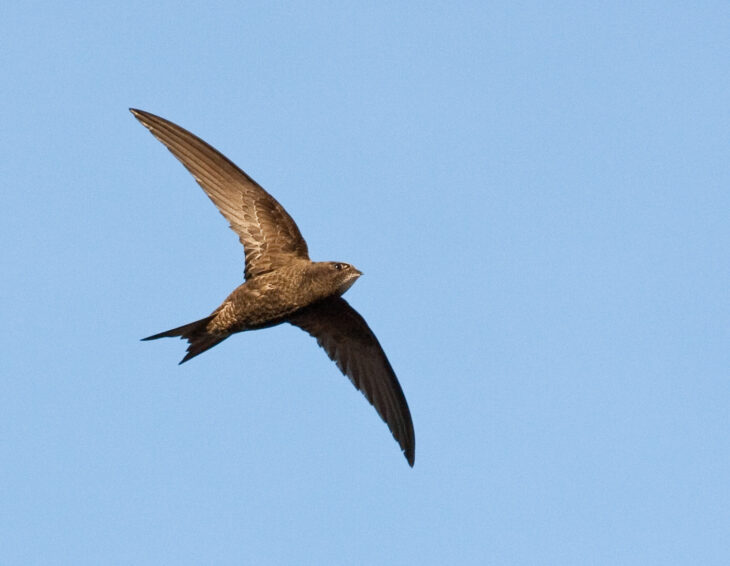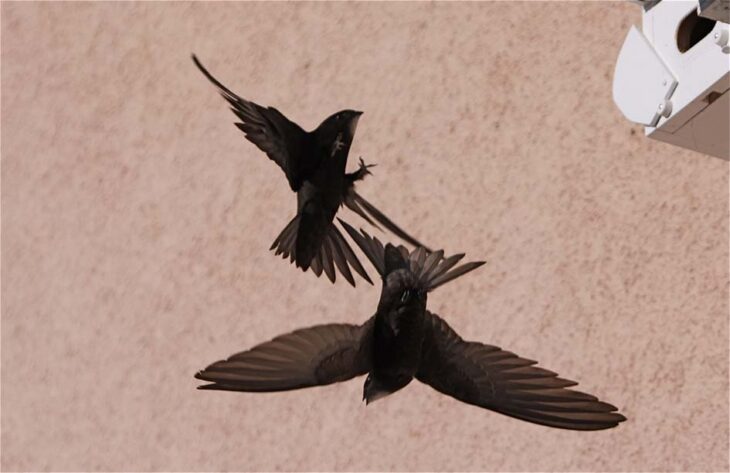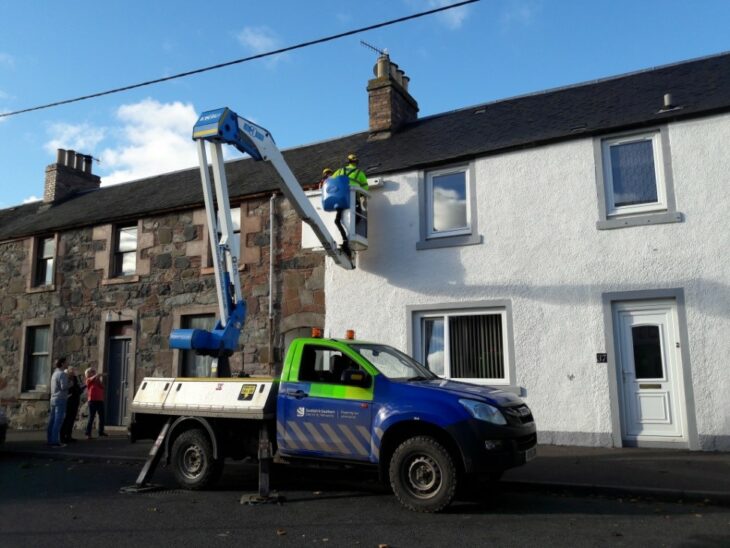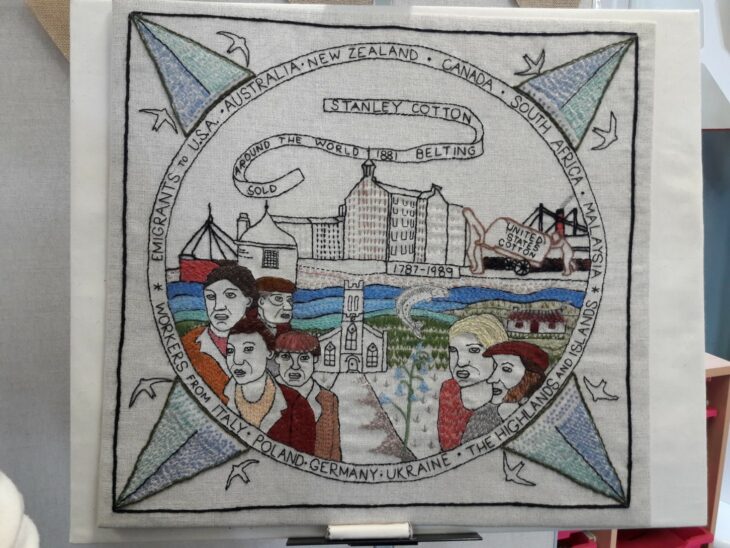Living Cities: Taking swift action in Stanley
The Trust’s Living Cities publication outlines practical actions that can be taken to embed nature into the urban environment. In this guest blog, Elspeth Coutts from Stanley Swift Project explains how a Perthshire community has brought residents and businesses together to help swifts.
Swifts have declined by more than 60% in Scotland in the past 20 years, and worse still by 39% in the last decade.
During an evening wildlife walk on a sunny June evening in 2014 we learned that despite this alarming plight Stanley is still a hot spot for these summer visitors. We quickly decided we had to do something to help.
Eyes on the skies
For the last five summers we’ve carried out an annual survey of nest sites and monitored the numbers of swifts flying above Stanley – from the much awaited arrival of the first swift in early May until the last leaves in mid-August.

This survey helps us monitor the local population over time and support their breeding needs to the best of our abilities.
We have divided the area up into zones that are shared out between a team of volunteer surveyors. Although we all do a bit of ‘swifting’ throughout the whole village, this approach builds up consistency as surveyors become familiar with their own patch over the season.
We are gradually improving our techniques over time, including improved alignment with the biological data systems used by Perth and Kinross Council.

Over the past five years, we’ve identified 39 natural nest sites in old buildings. Sadly four of these have been lost since 2014 through house repairs and maintenance, and of the remaining 35, 11 were not verified in use in 2018.
For the first few years the maximum numbers of flying swifts were around 40+, with occasional larger groups of 70-80 birds later in the season, when non-breeding juveniles and fledglings are likely to have been in the mix.
Sadly in 2018 the maximum number seen together at any one time was only about 30, and numbers did not appear to pick up very much later in the season.
We have to hope that numbers are back up in 2019. However, we do worry that any downward observations are an indication of the terrifying bigger picture for swifts that we are all too familiar with.
Ensuring swifts have a home
There is nothing more exciting than finding a ‘new’ swift nest site. Equally there is nothing sadder than seeing one lost forever when simple knowledge and care can avoid it. One of our aims is to raise awareness about protecting swift nest sites during building repair and maintenance.
Local people and businesses are also helping us create new homes for swifts on buildings in Stanley. Support from SSE and Alba Platforms has allowed us to install more than a dozen swift boxes on private homes, our village hall and the Tayside Hotel. This last box came with a video and monitor donated to us by Perthshire Wildlife, although it’s yet to be seen in use.

Of the 15 boxes monitored by our group in 2018, seven were being used by swifts and several more were occupied by starlings and house sparrows, birds we also love dearly.
More boxes will be going up before the 2019 breeding season, including two at Stanley Primary School.
It’s not just existing housing that can help. Extensive new development is coming to Stanley over the next 10-15 years and we’ve lobbied for several years for this to include swift bricks.
Last year we were delighted to learn that a planning condition had been applied that a minimum of 30% of all two-storey houses should include at least two bat bricks and swift nest bricks should be incorporated at eaves height.
We will continue to make sure this planning condition is met over multiple phases of the development and that the swift and bat bricks go up in suitable locations.
Raising awareness
As well as surveying and practical work a great deal as been done to raise awareness of swifts in our community. Our group attends local events and posts information on Facebook as well as in shops and community spaces.
2018 saw a number of particularly special events that have helped to celebrate Stanley’s swifts. Our local bowling club kindly flew a ‘welcome back’ flag from its flagpole during the summer. This beautiful swift was certainly the largest ever seen flying over Stanley, and a lovely symbol of hope and commitment to our beloved visitors.
Stanley Swift Project also took part in the first national Swift Awareness Week in June 2018. We organised walks for groups including our local primary school pupils, and an informative evening event followed by swift and bat watching at dusk.
Excitingly a new natural nest site was identified on the older part of the school building shortly beforehand. The swifts did us proud on both guided walks, treating us to aerial performances as well as evening screaming parties.

Most unusually and wonderfully we were involved in the creation of the Stanley Diaspora Tapestry. Following a visit of the Scottish Diaspora Tapestry to Stanley Mills, Historic Environment Scotland commissioned a Perthshire artist and a local tapestry expert to lead a community project to produce an embroidered panel for permanent display at the mill to represent the diaspora story of Stanley.
Early in the design process it was decided to include our local swifts in the composition, in recognition of their incredible migrations between Africa and Stanley each year.
As a result of all of these activities swift awareness is definitely increasing in Stanley. We love our swifts and are committed to doing everything we can to continue to enjoy their joyous summer presence in perpetuity.
Elspeth Coutts, Stanley Swift Project
Stanley Swift Project has received support both practically and financially from Tayside Biodiversity Partnership, Tayside Swifts, Perthshire Wildlife, the Tayside Hotel, Stanley Development Trust, Alba Platforms and SSE, as well as many local people. Find out more
Help protect Scotland’s wildlife
Our work to save Scotland’s wildlife is made possible thanks to the generosity of our members and supporters.
Join today from just £3 a month to help protect the species you love.
Preface
The Trust’s Living Cities publication outlines practical actions that can be taken to embed nature into the urban environment. In this guest blog, Elspeth Coutts from Stanley Swift Project explains how a …
